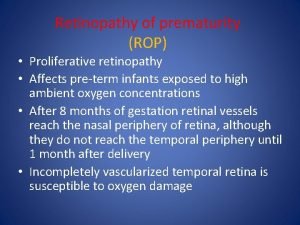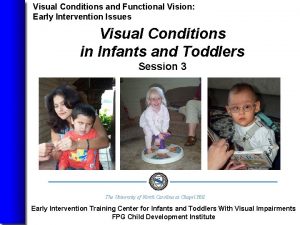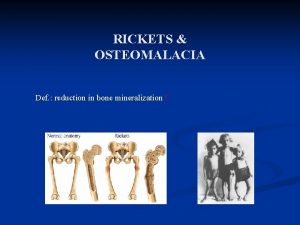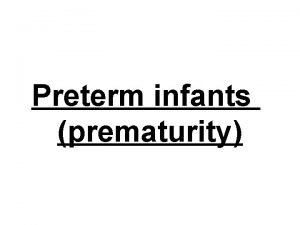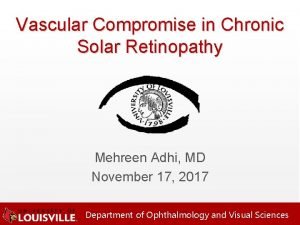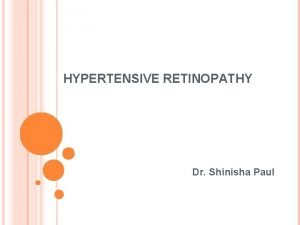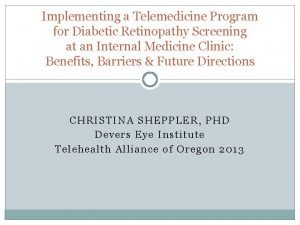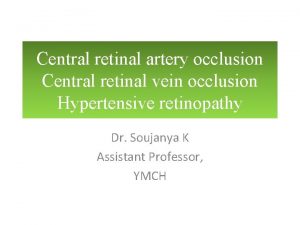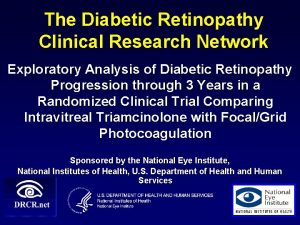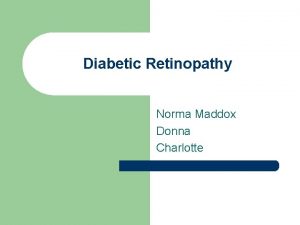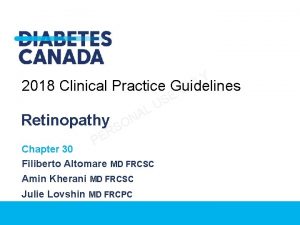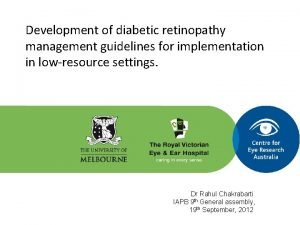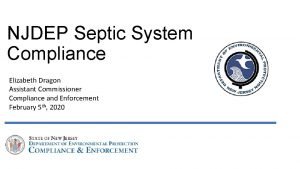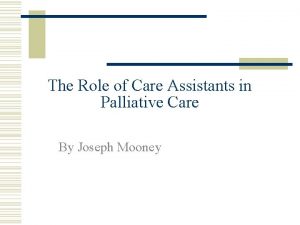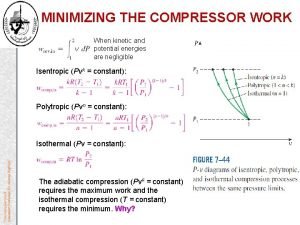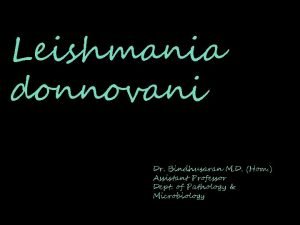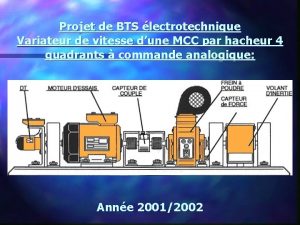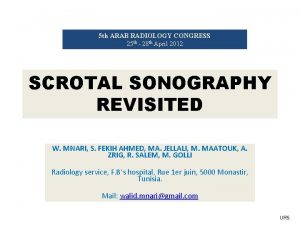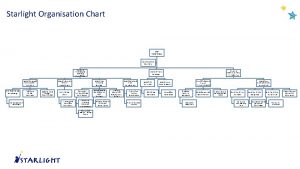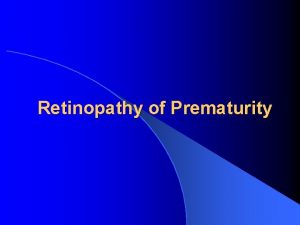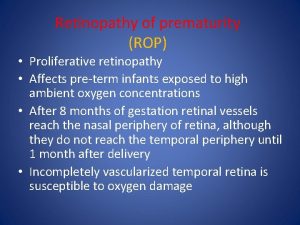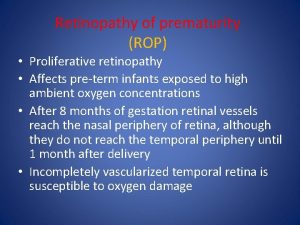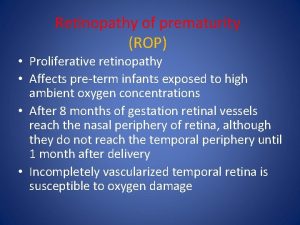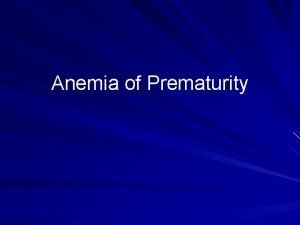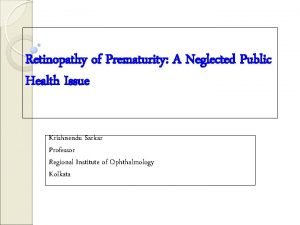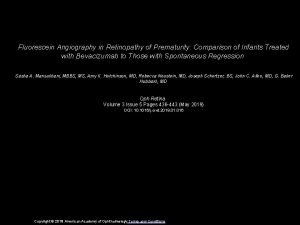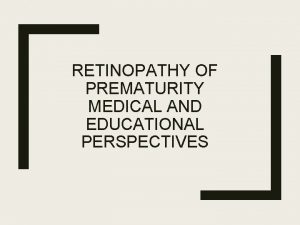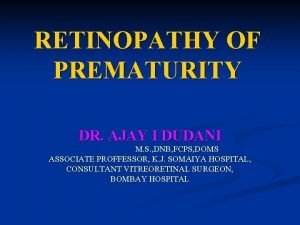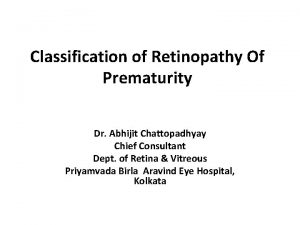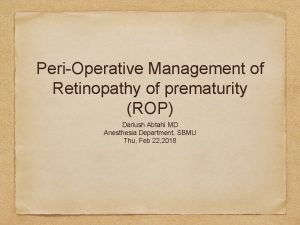Retinopathy of Prematurity Dr Soujanya K Assistant Professor










































































- Slides: 74

Retinopathy of Prematurity Dr Soujanya K Assistant Professor, Dept. of Ophthalmology, YMCH

Specific learning objectives • To describing pathogenesis of ROP • To describe prevention and screening protocol of ROP • To understand management of ROP • To describe clinical features of Retinitis pigmentosa • To describe clinical features of pathological myopia

What is prematurity?


What is ROP? • Retinopathy of prematurity (ROP) is a proliferative retinopathy affecting premature infants of very low birth weight, who have often been exposed to high ambient oxygen concentrations

Risk factors • Birth weight < 1500 gm • </= 32 wks GA • Exposure to high concentration of oxygen

Normal angiogenesis

4 months Temporal Retina Nasal Retina

8 months Temporal Retina Nasal Retina

10 months Temporal Retina Nasal Retina

PATHOGENESIS



Increased oxygen saturation

Obliteration of retinal vessels

Release of VEGF

Neovascularisation

Fibrous tissue proliferatio

Retinal detachment

Retinal detachment

Sub-Total Retinal detachment

Total Retinal detachment



Pseudoglioma

STAGES OF ROP

A discrete line of demarcation separates avascular retina from vascular retina






ZONES IN ROP

Zone 1: Radius- twice the distance from the disc & fovea

Zone 2: Radius- centre of the disc to the nasal ora serrata

Zone 3: Temporal crescent

Screening • Prophylaxis: • Newborn – incubator O 2 saturation <30%

Who need screening? • All premature babies born at – less than or equal to 32 weeks of gestational age – Weighing 1500 g or less

When to screen? • First examination: – Between 6 and 7 weeks post-natal age or – 34 weeks post-conceptual age (whichever is earlier). Eg: Baby born at 32 wks on 1/1/2018 After 6 wks : 15/02/2018 or When baby is 34 wks: 15/01/2018

How to screen? • Dilated fundus examination with Indirect ophthalmoscopy with 28 D lens

Tele-medicine

Treatment • Indirect laser photocoagulation

Treatment

Treatment

Retinitis pigmentosa

• Retinitis pigmentosa is a hereditary disorder predominantly affecting the rods more than the cones.

What is the function of rods?

Symptoms • Night blindness. • Tubular vision occurs in advanced cases.

Arteriolar Attenuation Waxy Disc Pallor. Retinal Bone-spicule Pigmentation

Advanced Changes

End-stage Disease

FIELD OF VISION






Pathological myopia

• Includes a rapid axial growth of the eyeball beyond normal variation.




Myopic crescent

Myopic crescent & Super-traction crescent


• Foster-Fuchs' spot: dark red circular patch due to sub-retinal neovas-cularization and choroidal haemorrhage

Foster-Fuchs' spot

Foster Fuchs’ spot

Posterior staphyloma

Posterior vitreous detachment

Vitreous liquefaction

LACQUER CRACKS • spontaneous ruptures of the Bruch’s membrane that appear yellowish-white and are usually located in the posterior pole.

Peripheral retinal degeneration

Questions • When should a premature baby be screened to prevent retinopathy of prematurity? • What are the differential diagnosis of pseudoglioma? • What are the clinical features of retinitis pigmentosa? • Draw a neat labeled diagram depicting features of pathological myopia.
 Stages of retinopathy of prematurity
Stages of retinopathy of prematurity Retinopathy of prematurity
Retinopathy of prematurity Osteoid definition
Osteoid definition Causes of prematurity
Causes of prematurity Promotion from associate professor to professor
Promotion from associate professor to professor Cuhk salary scale 2020
Cuhk salary scale 2020 Solar retinopathy
Solar retinopathy Diabetic retinopathy clinical research network
Diabetic retinopathy clinical research network Diabetic retinopathy clinical research network
Diabetic retinopathy clinical research network Diabetic retinopathy clinical research network
Diabetic retinopathy clinical research network Keith wagner barker
Keith wagner barker Diabetic retinopathy clinical research network
Diabetic retinopathy clinical research network Diabetic retinopathy screening reimbursement
Diabetic retinopathy screening reimbursement Deflection of veins at av crossing
Deflection of veins at av crossing Diabetic retinopathy grading
Diabetic retinopathy grading Diabetic retinopathy clinical research network
Diabetic retinopathy clinical research network Maddox donna
Maddox donna Diabetic retinopathy cpg
Diabetic retinopathy cpg Diabetic retinopathy
Diabetic retinopathy Drcr net
Drcr net Albany diabetic retinopathy
Albany diabetic retinopathy Medicare assistant
Medicare assistant Assistant teacher of gps
Assistant teacher of gps Bakersfield adults school medical assistant
Bakersfield adults school medical assistant Ibm support assistant
Ibm support assistant Good afternoon brother
Good afternoon brother Kpu health care assistant
Kpu health care assistant When did you last go shopping
When did you last go shopping Medical assistant lesson plan
Medical assistant lesson plan The signmaker's assistant quiz
The signmaker's assistant quiz Shop assistant and customer dialogue
Shop assistant and customer dialogue Njdep compliance and enforcement
Njdep compliance and enforcement Akshay kumar assistant
Akshay kumar assistant Office management assistant psc
Office management assistant psc Signmaker's assistant
Signmaker's assistant Palliative care assistant
Palliative care assistant Ucl library assistant
Ucl library assistant Function of district commissioner
Function of district commissioner Bakersfield adult school f street
Bakersfield adult school f street Isentropic efficiency for a compressor
Isentropic efficiency for a compressor Medical assistant rop
Medical assistant rop Circulating dental assistant
Circulating dental assistant Junior assistant scoutmaster
Junior assistant scoutmaster Hom assistant
Hom assistant Danfoss link home assistant
Danfoss link home assistant The nursing assistant and the care team
The nursing assistant and the care team Christine andre
Christine andre Smart middle school
Smart middle school Attribute assistant arcmap
Attribute assistant arcmap Hacheur assistant
Hacheur assistant Varicocele grading radiology assistant
Varicocele grading radiology assistant Recording assistant syscom
Recording assistant syscom University of new england physician assistant program
University of new england physician assistant program Virtually there e ticket receipt
Virtually there e ticket receipt Physician assistant kindergeneeskunde
Physician assistant kindergeneeskunde Login assistant
Login assistant As a laboratory assistant you measure chemicals
As a laboratory assistant you measure chemicals Arbitre assistant robot
Arbitre assistant robot Mon assistant visuel sncf
Mon assistant visuel sncf Assistant manager career path
Assistant manager career path Good afternoon students
Good afternoon students Brunei police organizational structure
Brunei police organizational structure Starlight assistant
Starlight assistant Mrs rajlaxmi is working
Mrs rajlaxmi is working Assistant techer
Assistant techer Printing and dyeing assistant
Printing and dyeing assistant Assistant registrar ubd
Assistant registrar ubd Cyp assistant director
Cyp assistant director Spiritual assistant
Spiritual assistant Daq assistant express vi download
Daq assistant express vi download Cisco personal communications assistant
Cisco personal communications assistant The signmaker's assistant vocabulary
The signmaker's assistant vocabulary Experimental design assistant
Experimental design assistant Efda definition
Efda definition Shop assistant good afternoon
Shop assistant good afternoon
